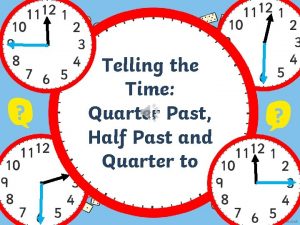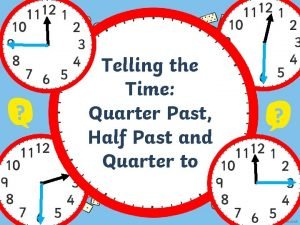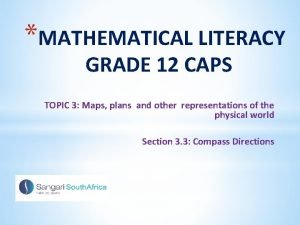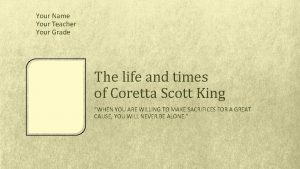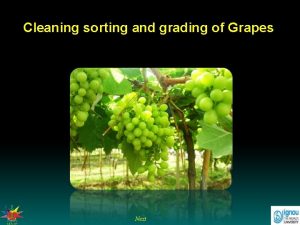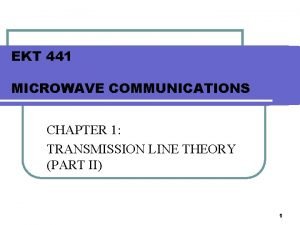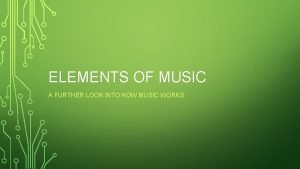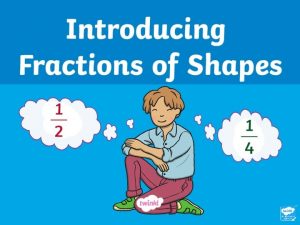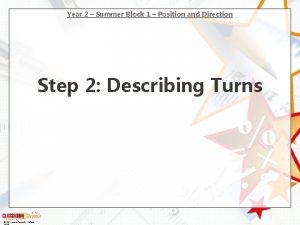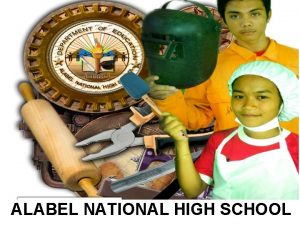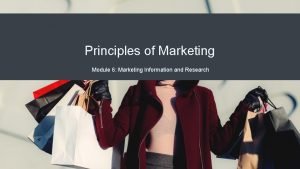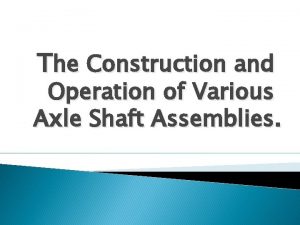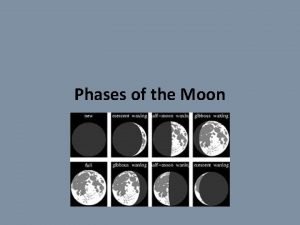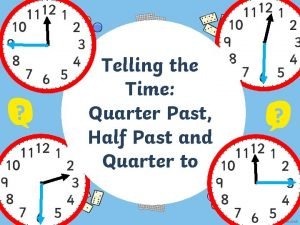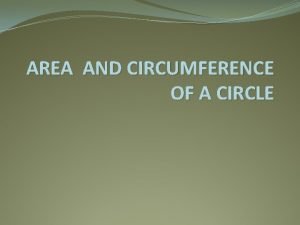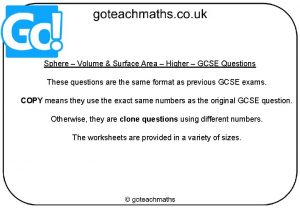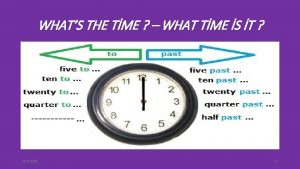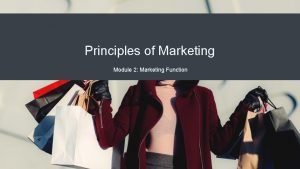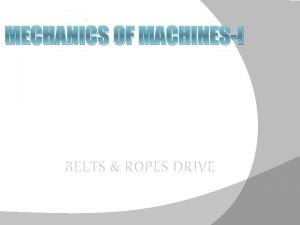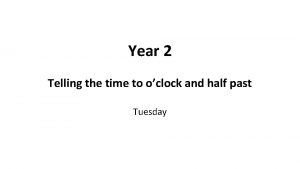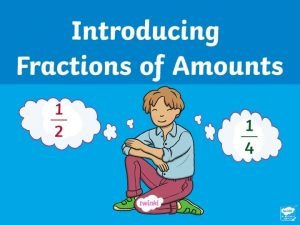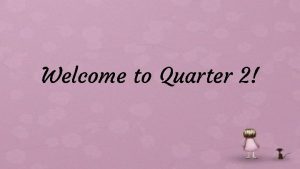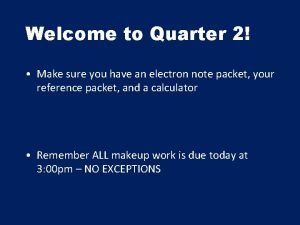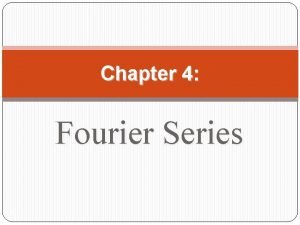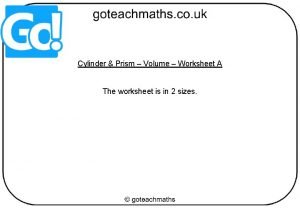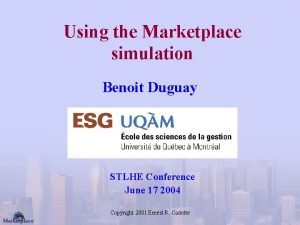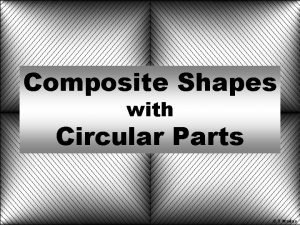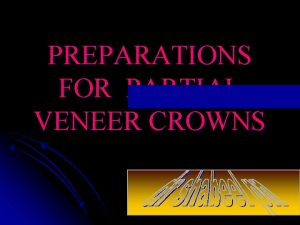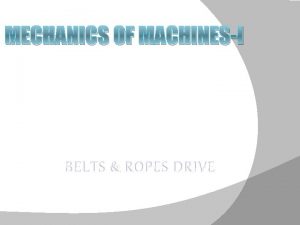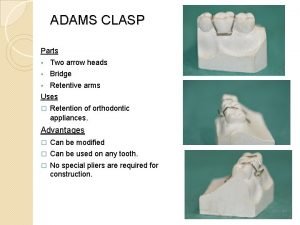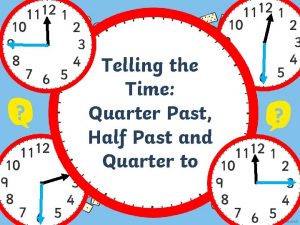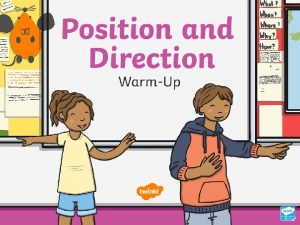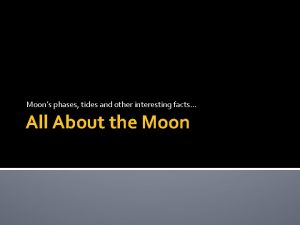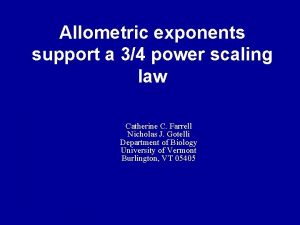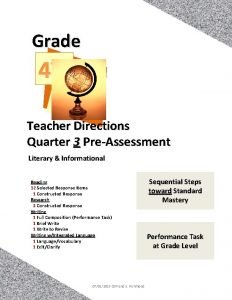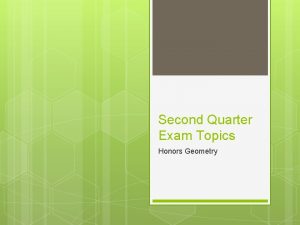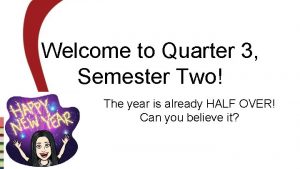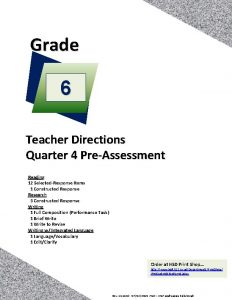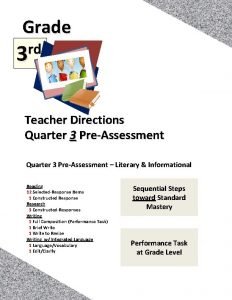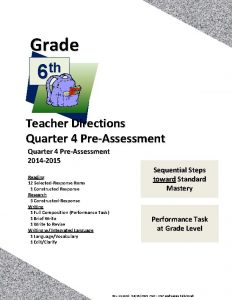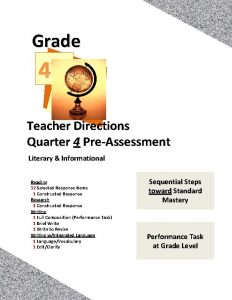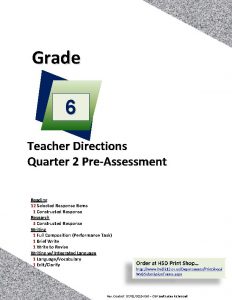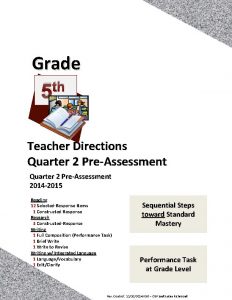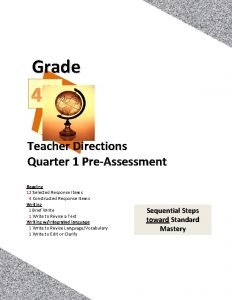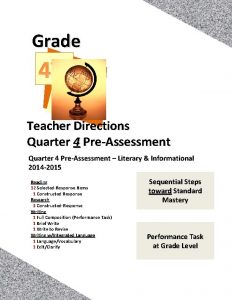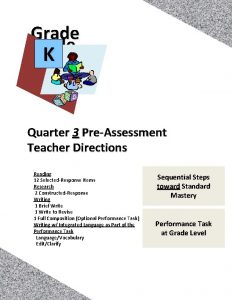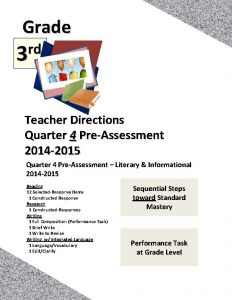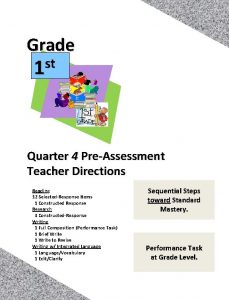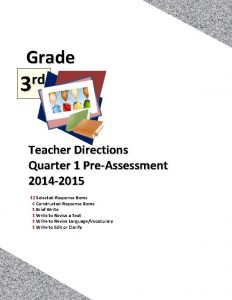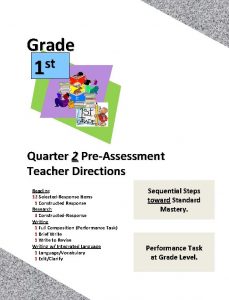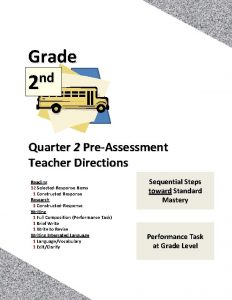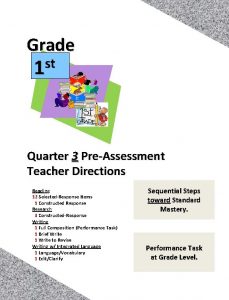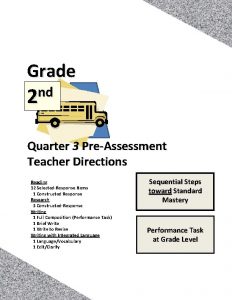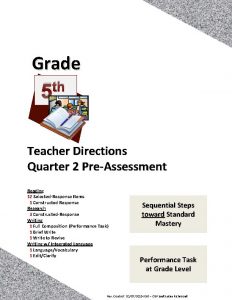Grade th 4 Teacher Directions Quarter 3 PreAssessment















































- Slides: 47

Grade th 4 Teacher Directions Quarter 3 Pre-Assessment Literary & Informational Reading 12 Selected Response Items 1 Constructed Response Research 3 Constructed Response Writing 1 Full Composition (Performance Task) 1 Brief Write 1 Write to Revise Writing w/Integrated Language 1 Language/Vocabulary 1 Edit/Clarify 07/01/2015 OSP and S. Richmond Sequential Steps toward Standard Mastery Performance Task at Grade Level

th 4 Quarter Three Pre -Assessment Reading: Literature Grade Three Targets Standards DOK 3 Word Meanings RL. 4. 4 1 -2 6 Text Structures/Features RL. 4. 7 2 5 Analysis Within and Across Texts RL. 4. 9 4 Reading: Informational Grade Three Targets Standards DOK 10 Word Meanings RI. 4. 4 1 -2 11 Reasoning and Evidence RI. 4. 8 3 12 Analysis Within and Across Texts RI. 4. 9 4 Note: There may be more standards per target. Writing standards assessed in this assessment are boxed. Narrative Writing and Language Targets Standards DOK 6 Brief Narrative Write W. 4. 3 a, W. 4. 3 b, W. 4. 3 c, W. 4. 3 d 3 6 Write-Revise Informational W. 4. 3 a, W. 4. 3 b, W. 4. 3 c, W. 4. 3 d 2 2 Full Narrative Composition W. 4. 3 a, W. 4. 3 b, W. 4. 3 c, W 4. 3 d, W 4. 4, W 4. 5, W. 4. 8, W. 4. 9 4 8 Language-Vocabulary Use L. 3 a 1 -2 9 Edit and Clarify L. 4. 1 d 1 -2 07/01/2015 OSP and S. Richmond 2

All elementary ELA assessments were reviewed and revised in June of 2015 by the following amazing and dedicated HSD K-6 th grade teachers. Deborah Alvarado Lincoln Street Ko Kagawa Minter Bridge Linda Benson West Union Jamie Lentz Mooberry Anne Berg Eastwood Sandra Maines Quatama Aliceson Brandt Eastwood Gina Mc. Lain TOSA Sharon Carlson Minter Bridge Teresa Portinga Patterson Deborah Deplanche Patterson Judy Ramer Consultant Alicia Glasscock Imlay Sara Retzlaff Mc. Kinney Sonja Grabel Patterson Jami Rider Free Orchards Megan Harding Orenco Kelly Rooke Free Orchards Renae Iversen TOSA Angela Walsh Witch Hazel Ginger Jay Witch Hazel 12/01/2015 OSP and S. Richmond 3

Background Performance Task – Optional This is a pre-assessment to measure the task of writing an informational article. Full compositions are always part of a Performance Task. A complete performance task would have: Part 1 • A Classroom Activity (30 Minutes) • Independent Work (35 minutes) • Passages or stimuli to Read • 3 Research Questions • There may be other constructed response questions. Part 2 • A Full Informational Composition (70 Minutes) Students should have access to spell-check resources but no grammar-check resources. Students can refer back to their passages, notes and 3 research questions and any other constructed responses, as often as they’d like. Directions 30 minutes 1. You may wish to have a 30 minute classroom activity. The purpose of a PT activity is to ensure that all students are familiar with the concepts of the topic and know and understand key terms (vocabulary) that are at the upper end of their grade level (words they would not normally know or are unfamiliar to their background or culture). The classroom activity DOES NOT pre-teach any of the content that will be assessed! 35 minutes 2. Students read the passages independently. If you have students who can not read the passages you may read them to those students but please make note of the accommodation. Remind students to take notes as they read. During an actual SBAC assessment students are allowed to keep their notes as a reference. 3. Students answer the 3 research questions or other constructed response questions. Students should also refer to their answers when writing their full i nformational article. 15 minute break 70 Minutes 4. Students write their full composition (informational article). SCORING An Informational Rubric is provided. Students receive three scores: 1. Organization and Purpose 2. Evidence and Elaboration 3. Conventions 12/01/2015 OSP and S. Richmond 4

Classroom Activity This classroom pre-activity follows the Smarter Balanced Assessment Consortium general design of contextual elements, resources, learning goals, key terms and purpose [http: //oaksportal. org/resources/] The content within each of these was written by……Carrie Ellis and Judy Ramer The Classroom Activity introduces students to the context of a performance task, so they are not disadvantaged in demonstrating the skills the task intends to assess. Contextual elements include: 1. an understanding of the setting or situation in which the task is placed 2. potentially unfamiliar concepts that are associated with the scenario 3. key terms or vocabulary students will need to understand in order to meaningfully engage with and complete the performance task The Classroom Activity is also intended to generate student interest in further exploration of the key idea(s). The Classroom Activity should be easy to implement with clear instructions. Please read through the entire Classroom Activity before beginning the activity with students to ensure any classroom preparation can be completed in advance. Throughout the activity, it is permissible to pause and ask students if they have any questions. Resources needed: • • Paper & pencil/whiteboard for brainstorming Chart paper/marker Teacher’s purse or backpack (try not to “clean up” either of these to keep them authentic!) Some way of displaying Ancillary materials 1 or making copies for the students Learning Goals: • Students will understand the key concept that archaeologists search for artifacts to understand ancient cultures. • Those artifacts are often everyday objects. Students will understand the key terms: Note: Definitions are provided here for the convenience of facilitators. Students are expected to understand these key terms in the context of the task, not memorize the definitions. • Archaeologists: people who study people of long ago and learn about them by looking at things they made or used. • Artifact: something made or used by people long ago. • Culture: attitudes, customs, and beliefs that make one group of people different from another. [Purpose: The facilitator’s goal is to help students realize that even every day objects can give us valuable information about what people were like and how they lived in the past. The students will draw conclusions about a person based on their personal belongings. ] 07/01/2015 OSP and S. Richmond *Facilitators can decide whether they want to display ancillary materials using an overhead projector or computer/Smartboard, or whether they want to produce them as a handout for students. 5

Archaeology Classroom Activity continued… Facilitator says: “Today we will get ready for the “Archaeology” Performance Task, in which we will learn about people, their cultures, and the past by looking at artifacts. Let’s start by discussing what you know about archaeology. Turn to a partner/discuss in your group for two minutes about what you know about what archaeologists do. ” [Have paper & pencils/whiteboards available for students to record their ideas if they wish. ] Discussion question: What do archaeologists do? [write the discussion question on chart paper/board for students to refer to]. Facilitator says: “When I call on your group, I want one person to share with the class what your group discussed. I will record your responses on our chart. ” Possible student responses (unscripted): • They dig in the dirt. • They dig in the ground and look for old stuff. • They put things in museums. Facilitator says: “Good thinking. What are some famous things that archaeologists have found? With your partner/group, take two more minutes to talk about this. ” Discussion question: What are some famous things that archaeologists have found? (write the discussion question on chart paper/board for students to refer to). Facilitator says: After their discussion time; “When I call on your group, I want a different person to share with the class what your group discussed. I will record your responses on our chart. ” Student responses (unscripted): • Egyptian mummies • Buried treasures • Dead people • Old homes they lived in • Things people used in their everyday lives…pottery, sandals • Ancient ruins Facilitator says: “Now let’s watch a short video that explains what archaeologists do on their jobs. Pay close attention to the end of the video when the archaeologist is explaining something to the students. ” [A Day in the Life of an Archaeologist; Facilitator shows the 2 minute video which shows a real archaeologist at work. ] “Did anyone notice the small object that he pulled out at the end of the video (a rock; jasper)? Does anyone remember what he said about it (it was being made into a point and cooked)? ” [Discuss with students] 07/01/2015 OSP and S. Richmond 6

Archaeology Classroom Activity continued… Facilitator says: “Archaeologists take objects they find on digs and use them to make guesses (conclusions) about the people and their culture they are studying. We don’t have an ancient dig site nearby to study but we can look at artifacts from our everyday environment. ” [Take out your teacher purse or backpack. In the directions below, a purse is being used. If using a backpack, substitute the word backpack where needed. ] “This is my purse where I keep things that I use every single day. Let’s see what I have in here and what is says about me. “ [Take out one object from the bag and ask students to identify it and its use. Model how to chart this on a double T chart, like Figure 1 in the Ancillary Materials. ] “What kind of person would carry around _____ in their purse? What does that tell you about that person and the people they live with? Can you think of a story idea that has to do with this object and this person? ” • [Guide students to a reasonable conclusion about that object. • Ex. A calendar. This might tell people that the person likes to be organized and doesn’t want to forget appointments. • Write this on the chart. • Now pass out objects from the purse to each of the groups. Have them identify the object, explain what it’s used for, and make a conclusion about the person based on the object. • Record ideas on the T chart. ] Facilitator says: “Now, look at all these objects, what their possibly used for , and what it says about that person. Can you think of a story idea that has to do with some of these objects and this person? Turn and talk with a partner for two minutes about this. Student responses (unscripted): • Calendar…person loses calendar and has an adventure because she can’t remember where she is supposed to be. • Pack of gum…dog goes into your purse and eats the gum and blows bubbles…becomes the first bubble blowing dog. Facilitator says: “Even though we usually think about Archaeologists as adventurers who are chasing down gold and treasures, the truth is that much more can be learned about ancient peoples from their everyday possessions. ” Facilitator says: “In your performance task, you will be learning more about archaeologist who used everyday objects to learn about ancient people. The group work you did today should help prepare you for the research and writing you will be doing in the performance task. ” Note: Facilitator should collect student notes from this activity. 07/01/2015 OSP and S. Richmond 7

Ancillary Materials Video resources: • A Day in the Life of an Archaeologist: https: //www. youtube. com/watch? v=Tur. Nj. Nr. Q 7 t. Y Figure 1: Double T chart Object: What it’s used for: What it tells us about this person: 12/01/2015 OSP and S. Richmond 8

Order at HSD Print Shop… http: //www. hsd. k 12. or. us/Departments/Print. Shop/ Web. Submission. Forms. aspx Directions The HSD Elementary assessments are neither scripted nor timed assessments. They are a tool to inform instructional decision making. It is not the intent of these assessments to have students “guess and check” answers for the sake of finishing an assessment. All students should “move toward” taking the assessments independently but many will need scaffolding strategies. If students are not reading at grade level and can’t read the text, please read the stories to the students and ask the questions. Allow students to read the parts of the text that they can. Please note the level of differentiation a student needed. About this Assessment This assessment includes: Selected Response, Constructed Response, and a Performance Task. Types of SBAC Constructed Response Rubrics in this Assessment http: //www. livebinders. com/play? id=774846 Reading • 2 Point Short Response • 2 -3 Point Extended Response Writing • 4 Point Full Composition Rubric (Performance Task) • 2 -3 Point Brief Write (1 -2 Paragraphs) Rubric • 2 -3 Point Write to Revise Rubrics as Needed Research • 2 Point Rubrics Measuring Research Skill Use Quarter 3 Performance Task The underlined sections are those scored on SBAC. Please take 2 days to complete performance tasks. Part 1 Part 2 • Classroom Activity if Desired/Needed • Read two paired passages. • Take notes while reading (note-taking). • Answer SR and CR research questions about sources • Class Activity • Plan your essay (brainstorming -pre-writing). • Write, Revise and Edit (W. 5) • Writing a Full Composition or Speech Components of Part 1 Components of Part 2 Note-Taking: Students take notes as they read passages to gather information about their sources. Students are allowed to use their notes to later write a full composition (essay). Note-taking strategies should be taught as structured lessons throughout the school year in grades K – 6. A teacher’s note-taking form with directions and a notetaking form for your students to use for this assessment is provided, or you may use whatever formats you’ve had past success with. Please have students practice using the note-taking success with page in this document before the actual assessment if you choose to use it. Research: In Part 1 of a performance task students answer constructed response questions written to measure a student’s ability to use research skills needed to complete a performance task. These CR questions are scored using the SBAC Research Rubrics rather than reading response rubrics. Planning Students review notes and sources and plan their composition. Write, Revise and Edit Students draft, write, revise and edit their writing. Word processing tools should be available for spell check (but no grammar check). This protocol focuses on the key elements of writing narratives: 1. 2. 3. 4. 5. 6. introduction (narrator and/or setting and characters) organization (event sequence) development (narrative techniques such as dialogue, pacing, description reflection, and multiple plot lines) transitions (to sequence events) conclusion conventions of standard English. There are NO Technology-enhanced Items/Tasks (TE) Note: It is highly recommended that students have experiences with the following types of tasks from various on-line instructional practice sites, as they are not on the HSD Elementary Assessments: reordering text, selecting and changing text, selecting text, and selecting from drop-down menu 12/01/2015 OSP and S. Richmond 9

Pre-Assessments and Learning Progressions The pre-assessments measure progress toward standard proficiency Unlike the Common Formative Assessments which measure standard mastery, the pre-assessments are more like a base-line picture of a student’s strengths and gaps, measuring skills and concepts students need “along the way, ” in order to achieve standard mastery. Beg. of QTR CFA Example of a Learning Progression for RL. 2. 1 Pre-Assessments Measure Adjustment Points (in purple) RL. 2. 1 grade -level standard assessment. After the pre-assessment is given, Learning Progressions provide informal formative assessment below and near grade-level “tasks” throughout each. Throughout quarter. DOK 1 - Ka Recall who, what, where, when, why and how about a story read and discussed in class. DOK - Kc Use and define Standard Academic Language: who, what, where, when, why, and how; ask, answer, questions, key details DOK 1 - Cd Connect the terms who to characters; where and when to setting; what and how to sequence of events. DOK 1 - Cf Ask and answer who, what, where, when, why and how questions about key details in a text. the QTR DOK 2 - Ch Concept Development Student understands that key details help tell who, what, where, when, why and how. DOK 2 - Ck Uses key details to identify who, what, where, when, why and how about a story not read in class. END of QTR DOK 2 -Cl Finds information using key details to answer specific questions about a new story. Standard Mastery RL. 2. 1 Ask and answer such questions as who, what, where, when, why, and how to demonstrate understanding of key details in a text So what about a “post-assessment? ” There is not a standardized post-assessment. The true measure of how students are doing “along the way, ” is assessed in the classroom during instruction and classroom formative assessment. For this reason The CFA’s are not called “post-assessments. ” The CFAs measure the “end goal, ” or standard mastery. However, without the pre-assessments, how will we know what our instruction should focus on throughout each quarter? Learning Progressions: are the predicted set of skills needed to be able to complete the required task demand of each standard. The learning progressions were aligned to Hess’ Cognitive Rigor Matrix. The pre-assessments measure student proficiency indicated on the boxes in purple (adjustment points). These points are tasks that allow us to adjust instruction based on performance. For instance, if a student has difficulty on the first “purple” adjustment point (DOK-1, Cf) the teacher will need to go back to the tasks prior to DOK-1 Cf and scaffold instruction to close the gap, continually moving forward to the end of the learning progression. There is a Reading Learning Progression checklist for each standard in each grade that can be used to monitor progress. The checklists are available at: http: //sresource. homestead. com/Grade-2. html 12/01/2015 OSP and S. Richmond 10

Quarter Three Reading Literature Learning Progressions. The indicated boxes highlighted before the standard, are assessed on this pre-assessment. The standard itself is assessed on the Common Formative Assessment (CFA) at the end of each quarter. DOK 1 - Ka Recall the meaning of words and phrases read and discussed in class, including those that allude to mythology. DOK 1 - Kc Understand use Standard Academic Language terms: context clues, affixes, parts of speech, significant, mythology, allude, words and phrases. L. 4. 4 c Consult reference materials (e. g. , dictionaries, glossaries, thesauruses), DOK 1 - Ka DOK 1 - Kc Recall basic details and events about a story or drama (read and discussed in class). Recalls the differences between a drama and written text. Define (understand the meaning of…) standard academic language - terms: text, drama, stage directions, descriptions, visual presentation, oral presentation, connections and versions. DOK 1 - Ka Recall details, facts or events about stories and myths from different cultures (texts read and discussed in class). DOK 1 - Ce Select words to match definitions or in cloze structure that have been taught formally in class. Not assessed DOK 2 -Ch Concept Development: Student understands that word and phrase meaning is clarified through text (context clue strategies, etc…). DOK 1 - Cd Identify descriptions in a written text about a specific event. Identify when the author uses dialogue, setting & characterization in a written text. DOK 1 - Kc Understands and uses Standard Academic Language terms: compare, contrast, theme, and author’s treatment or approach, myths, traditional and cultures. DOK 2 - ANp Categorize the pattern of events seen in two or more stories, myths or traditional literature from different cultures (graphic organizers). SELECTED RESPONSE DOK 1 - Cf Answer questions that demonstrate an understanding of academic and domain specific words and phrases taught in class. Identify descriptions in a drama or oral presentation about specific events. Identify dialogue, setting and action about a specific event in a drama or oral presentation SELECTED RESPONSE DOK 1 - Cd Identifies when asked the literary elements of selected stories, myths, or traditional literature from different cultures. Elements: Characters Topic Setting Patterns of Events Opposition Theme DOK 2 - ANr Analyze the structure of the pattern of events in myths from different cultures (tales of the past, origins, morals. (i. e. , How are the events unfolding…sequentially? Cause/effect? ) List on a structural graphic organizer. DOK 1 – Cf Answer who, what, when, where and how questions about specific events in a text and a drama or oral presentation. DOK – 2 APg Use language structures (pre/suffix) or word relationships (antonyms/synonyms) to determine targeted word meanings. L. 4. 4 b Use common, gradeappropriate Greek and Latin affixes and roots as clues to the meaning of a word (e. g. , telegraph, photograph, autograph). SELECTED RESPONSE DOK 2 - APm Use context to identify the meaning of targeted words/phrases. L. 4. 4 a Use context (e. g. , definitions, examples, or restatements in text) as a clue to the meaning of a word or phrase SELECTED RESPONSE DOK 2 – Ch DOK 2 – Cl DOK 3 – ANp DOK 3 – ANt Explain how events are portrayed the same or differently in a text written both as a story and a drama (use descriptions of the events). SELECTED RESPONSE Locate elements of description or direction to answer questions about characters in a written text, drama or oral presentation DOK 1 - Cf Answer who, what, when, where or how questions about patterns of events in stories and myths from different cultures in a text read and discussed in class. DOK 2 - ANt Understands the characteristic text features of myths, stories and traditional literature from different cultures (i. e. , what features do you normally see in myths? In stories? - Aesop’s fables – have characteristics of a lesson or message, etc…). Compare the same story in a written format to its drama presentation Compare the same story in a written format to its oral presentation. DOK 2 - Ch Concept Development: Understands that stories with similar themes or topics are presented differently at times based on the culture. DOK 3 - Cv Identify similar topics or themes between selected stories, myths, or traditional literature from different cultures (compare a topic or theme using a Venn diagram). SELECTED RESPONSE 12/01/2015 OSP and S. Richmond Standard RL. 4. 4 Determine the meaning of words and phrases as they are used in a text, including those that allude to significant characters found in mythology (e. g. , Herculean). Identify where two versions of the same story reflect specific descriptions or directions in a text or drama (graphic organizer). CONSTRUCTED RESPONSE DOK 2 - Ck Identifies the topic or theme in traditional stories or myths from different cultures. Standard RL. 4. 7 Make connections between the text of a story or drama and a visual or oral presentation of the text, identifying where each version reflects specific descriptions and directions in the text. DOK 2 - Cl Locate the specific pattern of events seen in myths from different cultures in two or more texts (good and evil, quests, opposition). Not assessed DOK 3 - ANA Analyze author’s craft in stories, myths, or traditional literature from different cultures ( is the author using personification? hyperbole? suspense? flashback? ). CONSTRUCTED RESPONSE Standard RI. 4. 9 Compare and contrast the treatment of similar themes, topics, and patterns of events in stories, myths, and traditional literature from different cultures. 11

Quarter Three Reading Informational Learning Progressions. The indicated boxes highlighted before the standard, are assessed on this pre-assessment. The standard itself is assessed on the Common Formative Assessment (CFA) at the end of each quarter. DOK 1 - Ka Recall and Locate domain-specific words and phrases studied or discussed in a text (basic recall of location). DOK 1 - Kc Understands and uses Academic Standard Language accurately: determine, general, academic, domain, specific, words, phrases, relevant. DOK 1 - Ce Select words to match definitions or cloze structure when meaning is clearly evident. L. 4. 4 c Consult reference materials (e. g. , dictionaries, glossaries, thesauruses), Not assessed DOK 1 - APg Use language structures or word relationships to determine targeted word meanings. L. 4. 4 b Use common, grade -appropriate Greek and Latin affixes and roots as clues to the meaning of a word (e. g. , telegraph, photograph, autograph SELECTED RESPONSE DOK 2 - APN Use context to identify L. 4. 5 b the meaning of targeted Recognize and words/phrases. explain the meaning of common idioms, L. 4. 4 a Use context (e. g. , adages, and definitions, examples, or proverbs. restatements in text) as a clue to the meaning of a word or phrase. SELECTED RESPONSE DOK 3 - Cv Recall basic Understands Answer Concept Locates Distinguishes Explains how Identify facts and use who, what, Development: reasons to reasons that an author the particular Standard when, Understands support are relevant or connects reasons points in a Academic where and that points are particular irrelevant points to in a new text (read Language how made in a text points made evidence to reasons. text (not and terms: reasons, questions to clarify or in a text support a “What did the read/disdiscussed in evidence, text, about support (questions, particular point text say to cussed) class). support, particular reasons. discussions). in class (i. e. , support___? ” that inference and points in a SELECTED “Does this support a particular text read – RESPONSE support what topic points. discussed in the text says or class. not? ”). SELECTED RESPONSE DOK 1 - Ka DOK 1 - Kc DOK 1 - Ka Locate and recall basic facts from two texts on the same topic read and discussed in class. DOK 2 - ANp Compare facts from two texts on the same topic (students look for consistencies – or not- about facts between two texts) DOK 1 – Cf DOK 1 - Kc Understands and uses Standard Academic Language terms: integrate, information, texts, topic, speak, subject, knowledgeably. DOK 1 – Ch DOK 2 – Cl DOK 1 - Cf Answer who, what, when, where or how questions about two texts on the same topic read and discussed in class. Not assessed DOK 2 - ANs Distinguish relevant and irrelevant information from two texts on the same topic. Compare what each text considered relevant – or not about the topic. DOK 2 - ANs DOK 2 - Ch Concept Development: Understands that information can come from several sources to give the reader a better overall view of a topic. DOK 3 - Cu Connect similar ideas across two texts on the same topic using supporting evidence. (What is the supporting “thread” between the two texts? – what do both authors mention again and again? ). SELECTED RESPONSE DOK 3 - Cu DOK 2 - Ci Summarize similar information from two texts on the same topic (i. e. , “How does text #1 approach the facts, details or ideas of ____ compared to text #2? ) SELECTED RESPONSE DOK 4 - ANP Gather, analyze, and organize information from two sources on the same topic, reviewing all source information. Criteria: Students organizes the information using his/her own method to support a point. 12/01/2015 OSP and S. Richmond Standard RI. 4. 4 Determine the meaning of general academic and domainspecific words or phrases in a text relevant to a grade 4 topic or subject area. DOK 3 - ANA DOK 3 - ANB Standard Analyze how the author shows that he/she supports particular points in a text (“Does the author give implicit/ explicit evidence? ”). Supports a point with reasons found explicitly in a text (not a point of view). RI. 4. 8 Explain how an author uses reasons and evidence to support particular points in a text. DOK 2 - Cl Locate similar information about facts and details in two texts about the same topic. (Use a graphic organizer to list facts and details). DOK 4 - SYU Integrate information from two texts on the same topic in order to write or speak about the subject knowledgeably. Write a summary or a full compositional informational piece about the topic. CONSTRUCTED RESPONSE DOK 2 - APn Obtain and interpret information from two texts on the same topic using text features: Sidebars Bold Print Captions Subheadings, etc… Standard RI. 4. 9 Integrate information from two texts on the same topic in order to write or speak about the subject knowledgeably. 12

S E A R C H Name_________ Passage________ Main Idea ________ R EGrade 4 read SOMETHING NEW EXPLAIN MORE AGAIN and AGAIN RELEVANT OR NOT? CONCLUDE HAVE EVIDENCE What contributions (key ideas) does the text make to support the main idea? Write one new contribution (key idea) about the main idea. Instruct students to re-read a paragraph or section of the text that has strong text contributions to support a key idea. contributions _______________________________________ In fourth grade CCSS refers to key ideas as part of text contributions (a strong Ask, “Does the section or paragraph you _______________________________________ chose have a strong statement about the and specific support of a key idea). Use main idea? ” main idea both terms when discussing key ideas, as students may need the continued Key Details and Examples This is a contribution within a key idea reference. about the main idea. (be sure students can identify the main topic). What key details and examples from the section or paragraph explain more about the new 1 contribution Have students write ONE brief sentence (key idea)? about the new contribution (key idea ). Ask students to look for key details and examples that • Key Detail or Example explain more about the new strong contribution (key idea. ) ____________________________________ Key details contribution Key details are reasons that support the new contribution Remember students ____________________________________ (key idea). Instruct students to write 2 brief key details or will need to have a examples that support the key idea. 2 note-taking form for Example: if the main topic is about dogs and. . . • Key Detail or Example each passage. “The dog likes to play, ” (is the new contribution (key Idea), _____________________________________ Then some key details might be: • the dog likes to play fetch. _____________________________________ • the dog likes to play with the ball. Again and Again What words, phrases or ideas does the author use again and again? Write them here. Instruct students to look at the again and again Think about why the author uses them again and again. words or phrases, ask “Do you see some of the again and again words or ideas in the key idea or key detail Have students re-read the paragraph or sentences you wrote? Can the words help you write section they wrote about and write words or one conclusion sentence that summarizes the one conclusion ideas they see Again and Again, in the box. contribution (key idea ) and key details? ” Explain, “When authors use the same words, Summarizing is a big part of writing conclusions. It is phrases or ideas Again and Again ask yourself an extremely important strategy for students to learn “why? ” It means something is important. ” Write one conclusion sentence that tells the most about the new contribution (key idea). in order to use research skills effectively. 3 Use some of the again and again words or ideas in your summary. Differentiation: ______________________________________ Students who need more pages – print as many as needed. Students who would benefit from enrichment can continue on with more 4 sections or paragraphs. Students who need more direct instruction – teach part as a in mini lesson. These concepts can be taught separately: • Main Topic • Contribution (key idea) • Key Details Examples • Again and Again • Conclusions - Summarizing ELL Students may need each part taught using language (sentence) frames emphasizing transitional words. _______________________________________ 12/01/2015 OSP and S. Richmond 13

R E Grade 4 S SOMETHING NEW E EXPLAIN MORE A AGAIN & AGAIN R RELEVANT OR NOT? C CONCLUDE H HAVE EVIDENCE Name________ Passage________ Main Idea ________ What contributions (key ideas) does the text make to support the main idea? Write one new contribution (key idea) about the main idea. _____________________________________________________________________________ Key Details and Examples What key details or examples from the section or paragraph explain more about the new contribution (key idea)? • Key Detail or Example _________________________________________________________________________ Again and Again What words, phrases or ideas does the author use again and again? Write them here. Think about why the author uses them again and again. Write one conclusion sentence that tells the most about the new contribution (key idea). Use some of the again and again words or ideas in your summary. _____________________________________________________________________________14 12/01/2015 OSP and S. Richmond

Determining Grade Level Text Grade level text is determined by using a combination of both the CCSS new quantitative ranges and qualitative measures. Example: If the grade equivalent for a text is 6. 8 and has a lexile of 970, quantitative data shows that placement should be between grades 4 and 8. Common Core Band Flesch-Kincaid® The Lexile Framework® 2 nd - 3 rd 1. 98 - 5. 34 420 - 820 4 th - 5 rd 4. 51 - 7. 73 740 - 1010 6 th – 8 th 6. 51 - 10. 34 925 - 1185 9 th – 10 th 8. 32 - 12. 12 10. 50 - 1335 11 th - CCR 10. 34 - 14. 20 11. 85 - 1385 Four qualitative measures can be looked at from the lower grade band of grade 4 to the higher grade band of grade 8 to determine a grade level readability. Rate your text from easiest to most difficult between bands. 4 Qualitative Factors Beginning of lower (band) grade End of lower (band) grade Beginning of higher (band) to mid End of higher (band) grade Not suited to band Purpose/Meaning Structure Language Clarity Language Overall Placement The combination of the quantitative ranges and qualitative measures for this particular text shows that grade 6 would be the best readability level for this text. To see more details about each of the qualitative measures please go to slide 6 of: http: //www. corestandards. org/assets/Appendix_A. pdf 12/01/2015 OSP and S. Richmond 15

A Note about constructed responses: Constructed response answers are not written “in stone. ” There is no perfect way a student should respond. Look for the general intent of the prompt and student response and follow the rubric below as much as possible. Use your best judgment. Unlike DOK-1 questions where there is one right and wrong answer, constructed responses are more difficult to assess. Overall consistency of intent based on most of your student responses can guide you. DOK-3 Quarter 3 Pre-Assessment Research Constructed Response Answer Key Constructed Response Research Rubrics Target 3 evidence of the ability to distinguish relevant from irrelevant information such as fact from opinion Standard RL. 4. 7 2 Point Reading Constructed Response Rubric Question #7 Prompt: How do both I Want to be an Archaeologist Someday and Lost Treasure draw attention to discovering something of value in different ways? Teacher /Rubric “Language Response” The response: gives sufficient evidence of the ability to distinguish between relevant from irrelevant information in order to answer the prompt – how do both texts draw attention to discovering something of value? Relevant details for the prompt from I Want to be an Archaeologist Someday for drawing attention to discovering something of value could include (1) the rare sarcophagus found in Asia and (2) interesting finds in middens referred to as “treasures. ” Relevant details for the prompt from Lost Treasure for drawing attention to discovering something of value could include (1) the treasure map, (2) the attitude of the pirates, (3) finding a treasure and (4) the danger of finding treasure. Student “Language” Response Example Student response states and supports with sufficient details how both texts draw attention to discovering something of value. 2 1 0 Both stories are about discovering something valuable. I want to be an Archaeologist Someday is about a kid who became interested in archeology because of reading about a rare 2500 year old sarcophagus. It was found at a dig and might have held a soldier. The rest of this story is also about finding things of value that help people learn about the past. On the other hand, the story about Lost Treasure is more like an adventure tale, but still draws attention to discovering something of value. The pirates in the story have a treasure map and it leads them to discovering a valuable treasure in a cave. Both stories draw attention to discovering valuable things, but in different ways. Student response states and supports with minimal or vague details how both texts draw attention to discovering something of value. The story about becoming an archaeologist tells about how valuable treasures can be. Even finding stuff is valuable. The story about the pirate tells about finding valuable stuff probably like gold or jewels. Student response does not state or support how both texts draw attention to discovering something of value. Finding lost treasure would be so neat. You would need a map and then follow it. Finding gold or diamonds would be a huge treasure and very valuable. Research Target 3 Evidence of the ability to distinguish relevant from irrelevant information such as fact from opinion. Toward RL. 4. 7 Dok-3 Ant Identify where two versions of the same story reflect specific descriptions or directions in a text or drama (graphic organizer). 12/01/2015 OSP and S. Richmond 13

DOK-3 Quarter 3 Pre-Assessment Constructed Response Answer Key Standard RL. 4. 9 3 Point Reading Constructed Response Rubric Question #8 (prompt): Both of these stories are fictional. Which story is more believable than the other? Explain why. Use details and examples from both stories in your answer. Directions for Scoring: Write an overview of what students could include in a proficient response with examples from the text. Be very specific and “lengthy. ” Sufficient Evidence for a student response would include details or examples from both stories to explain why one story is more believable than another. Specific Identifications (supporting details) should be given from both examples. Specific details from I Want to be an Archaeologist Someday could include that this story is more believable because (1) it is written like a “real account, ” or in the first person (i. e. , believable “voice” or the way people really speak), (2) it could actually have happened and/or is realistic. Specific details from Lost Treasure should include details as to why this story is not as believable such as (1) it is written much like a tale, (2) Captain Redbeard reminds a person of other fairytale pirates (although he was a real pirate it’s not mentioned in the text), (3) the story is written like science fiction in some ways ( an octopus tips over the pirate’s boat). Full Support (other details) could include any details that support the student’s response statements including from I Want to be an Archaeologist Someday (1) specific and “real” information about a sarcophagus, (2) what has been found on digs or in middens, (3) how to become an archaeologist and (4) real jobs for archaeologists. From Lost Treasure other details could include (1) details of the treasure map, (2) how the pirates spoke to each other (voice), (3) where they sailed, (4) descriptions of the cave where the treasure was found and (5) descriptions of the giant octopus. Student response states which story is more believable with proficient details and examples from both texts. 3 The story called I Want to be an Archaeologist Someday is much more believable than Lost Treasure for several reasons. First, the story is written like someone actually talking. It could be a true account. For instance, the person in the story gives information that is factual such as reading about a 2500 year old sarcophagus that was found in Asia. Other true facts in this story are what archaeologists actually do and the kind of work or jobs that they could have. In Lost Treasure, the story is written like an adventure tale, kind of like Moby Dick. The account probably did not happen or little of it because there are not facts that lead to real accounts. For instance, no one really knows if Captain Redbeard had an old map and went through an inlet with three rowboats. When they see something glittering in a cave it turns out to be treasure. This is also not found in actual accounts, especially when a giant octopus tries to tip over their boat! Student response states which story is more believable with partial details and examples from both texts. 2 1 0 I think the archaeologist story is most real. Archaeologists are real people and to them treasure is finding old stuff about long ago. The boy in the story wants to be an archaeologist when he grows up and he talks like it’s really happening. The pirate story is so not real! It’s like an old move where all of the pirates are yelling at each other. They find a treasure in a cave too and a big octopus tries to get them. Student response states which story is more believable with minimal details and examples from both texts. The story about the kid who wants to go on digs is very believable. The story about the lost treasure and pirates is not very believable. Student response states which story is more believable or vaguely but does not use details or examples from text. I think the archaeologist story is really believable but pirates really did exist too so that is kind of believable. Toward RL. 4. 9 DOK 3 - ANA Analyze author’s craft in stories, myths, or traditional literature from different cultures ( is the author using personification? hyperbole? suspense? flashback? ). 12/01/2015 OSP and S. Richmond 14

DOK-3 Quarter 3 Pre-Assessment Research Constructed Response Answer Key Constructed Response Research Rubrics Target 4 ability to cite evidence to support opinions and/or ideas Question #15 Prompt: Is it important to go on a dig or explore a midden? Explain your answer using details and examples from both articles. Standard RI. 4. 8 2 Point Reading Constructed Response Rubric Teacher /Rubric “Language Response” The response gives sufficient evidence of understanding the prompt when the student states an opinion whether it is important to go on a dig or explore a midden and then support that opinion with evidence from both articles. Sufficient evidence to support the opinion that it is important to go on a dig and explore a midden could include from Article #1 that, (1) the more archaeologists find, the more they understand about and discover the past. From Article #2 that, (1) sometimes garbage is all that’s left of a people and to discover more about them. Students should use examples of each from Article #1. Examples of how archaeologists understand more about the past could include that on a dig archaeologists , (1) find out more about a specific area and what is was like long ago, (2) learn about animals, plants and the weather from the past (3) what food people ate and (4) what kind of clothing they wore. Students should use examples of each from Article #2. Examples of how archaeologist understand more about the past could include that in a midden archaeologist (1) learn what was important to people, (2) discovering the few clues left of people that were conquered, (3) what conquerors were like and (4) the clothes, food and tools they had. Student “Language” Response Example Student response states an opinion about the importance of digs and middens, and then sufficiently supports the opinion with details or examples from both articles. 2 1 0 If archaeologists did not go on digs or explore middens we would not learn about the past so it is very important. The more we understand discover the past the more we can learn about long ago. When archaeologists go on a dig they learn a lot about the area where people live including the animals, plants and even the weather. When archaeologists explore a midden they learn more specifically about what was important to the people that once lived there. Because people threw trash away and no one really wanted to steal trash – important clues were left for archaeologists. When a culture was conquered, the conquerors weren’t really interested in the trash so they left it alone. And the conquerors themselves had a lot of trash. So middens (which are trash piles) provide some of the best information to help archaeologists piece together the life stories of people of long ago. Student response states an opinion about the importance of digs and middens, and then minimally or vaguely supports the opinion with details or examples from both articles. I think it is really important for archaeologist to go on digs and explore middens. If they don’t we wouldn’t know much about people who lived long ago and that would be boring. When you know about people who lived a long time ago you can imagine what their lives were like. So I do feel it’s very important. Student response does not state an opinion about the importance of digs and middens or use details from the texts. Archaeologists are important. They dig up bones and stuff like that. They dig up old pots and clothes. It would be important to be an archaeologist. Toward RI. 4. 8 DOK 3 - ANB Supports a point with reasons found explicitly in a text (not a point of view). 12/01/2015 OSP and S. Richmond 15

DOK-4 Quarter 3 Pre-Assessment Research Constructed Response Answer Key Constructed Response Research Rubrics Target 2 Locate, Select, Interpret and Integrate Information. Question # 16 Prompt: After reading both articles, what new questions might readers ask to learn more about both digs and middens? Explain what details or examples would prompt readers to ask these questions. Standard RI. 4. 9 2 Point Reading Constructed Response Rubric Teacher /Rubric “Language Response” The response gives sufficient evidence of the ability to locate and select key points that people may ask about digs and middens. Students will give examples of questions readers might ask to learn more about both digs and middens. The response gives sufficient evidence of the ability to interpret and integrate information from both articles evident in the kinds of questions readers might ask to learn more about both digs and middens. Example questions readers might ask prompted by Article #1 on digs could include (1) Where are some areas archaeologists have been on a dig? [prompted by paragraph 1 – archaeologist find animal skeletons, plants, weather and fire damage remains], (2) How far did they have to dig? [prompted by paragraph 2 – wind is constantly blowing and building layers], (3) What have archaeologists found in certain areas? [prompted by paragraphs 3, 4 and 5, archaeologists find clues, crops, and clothing], and (4) What have they learned about certain people? [prompted throughout the article that digs help discover about a people’s past]. Any question that is supported by a prompt from Article 1 is acceptable. Example questions readers might ask prompted by Article #2 on midden could include (1) What most important or interesting things have archaeologists found in middens? [prompted by paragraph 2, and 4, sifting through garbage archaeologists find out what was important to people], (2) Where was a midden that had the most clues about people? [prompted by paragraph 3, archaeologists discover more about people who left few other clues in middens] and (3) How were a conquered people’s trash different than their conquerors? [ prompted by paragraph 3 and 5, archaeologists piece things together in the lives of people who were conquered and their conquerors]. Any question that is supported by a prompt from Article 2 is acceptable. Student “Language” Response Example The student response poses new questions readers might ask about digs and middens and includes sufficient details to explain what could prompt readers to ask these questions. 2 1 0 Readers will probably have more questions as they read each article about digs and middens. For example someone reading Article 1 might ask, “Where are some digs? ” and “How far down did the archaeologists have to dig to find anything? ” Article 1 explains what is found on a dig. Archaeologists find animal skeletons, plant remains, clothing and even fire damage! This would prompt readers to find out where some real digs are. Article 1 also explains that it takes many years of wind and dirt to bury the finds. This would prompt readers to learn about what has been found in real life examples and how far down archaeologists had to dig to find it! In Article 2 about middens, someone might ask, “What’s the most interesting things found in middens? ” and “ Where was the largest midden ever explored? ” Article 2 explains that people’s garbage piles help us to know what was important to people in the past. This would prompt a reader to know what has actually been found that was most interesting. Also in Article 2, it says archaeologist discover more about people who otherwise left few clues. This would prompt a reader to want to know more about middens that had many clues. The student response poses new questions readers might ask about digs and middens and includes minimal or vague details to explain what could prompt readers to ask these questions. People reading these two articles might have a lot more questions when they are done reading and want to learn more about digs and middens. The articles make you want to learn more which is neat. For one thing what kind of stuff did the archaeologists really find on a dig and what was the coolest midden ever discovered? The student response does not pose new questions readers might ask about digs and middens. A dig is finding treasures from the past. A midden is looking in garbage to find treasures. Both are real interesting. Toward RI. 4. 9 DOK 4 – SYU 12/01/2015 OSP and S. Richmond Integrate information from two texts on the same topic in order to write or speak about the subject knowledgeably. 16

Note: “Brief Writes” should take no longer than 10 minutes. Brief writes are scored with a 2 -3 point rubric. Full compositions are scored with a 4 point rubric. The difference between this rubric and the constructed response reading rubrics, is that the Brief Write Rubric is assessing writing proficiency in a specific area, while the reading rubrics are assessing comprehension. Quarter 3 Pre-Assessment Brief Write Constructed Response Answer Key Organization: Conclusion and Temporal Words W. 4. 3 c Target: 6 Write a Brief Text using Temporal Words Question # 17 Prompt: . A student is writing a story for class about two friends who find something unusual. Read the draft of the story and complete the task that follows. Mike had a new toy sailboat. He wanted to see if it would float. So, one day Mike asked his friend Alberto to help him dig a deep hole and fill it with water. They dug several feet deep. Then, Alberto got the hose and began filling the hole with water. Suddenly, Mike yelled, “Stop Alberto. Look!” In one or two paragraphs, write an ending for the story that describes the events and experiences in the story. Teacher /Rubric “Language Response” Directions for Scoring: Write an overview of what students could include in a proficient response with examples from the text. Be very specific and “lengthy. ” Teacher Language and Scoring Notes: The student response should provide a conclusion (1 -2 paragraphs) that logically follows and supports the preceding information about the events and experiences of the characters in the story. The conclusion should have a statement that explains what happened after Mike yelled “Stop Alberto, Look!” Students should use temporal words to signify event changes from beginning to end. Student “Language” Response Example The response provides transition (words or phrases) from the “body of the story” to the conclusion and provides a satisfying ending to the story that provides closure and/or follows logically from the events or experiences in the story. 2 1 0 Alberto looked down into the deep hole they had dug. But, he couldn’t believe what he saw. There sticking out of the dirt was something that looked like a large bone! Both boys just stared. After looking at the bone thing for a long time Mike asked Alberto, “Should we dig it up? ” But Alberto remembered a story about an archaeologist who was on a dig and found a dinosaur bone. “This looks just like it, ” he said. “I think we better ask someone first. If we dig it up and it breaks we will feel terrible. ” Later the boys found Mike’s dad and told him about the bone looking they found. Mike’s dad called his friend who was an archaeologist and asked him to come over and look at it. The next day, dad’s friend came to look. He was so excited. I think this is a rare dinosaur bone! Afterwards, the boys were so glad they had not tried to dig up the bone themselves. The response provides a limited transition from the “body of the story” to the conclusion and provides a general or partial ending to the story that may provide some closure and/or somewhat follow logically from the events or experiences in the story. Alberto stopped and looked into the hole. There was something sticking out. It looked like a huge seashell. I think it’s a fossil. Let’s dig it up and trade it for another toy boat or we can buy some candy. The response provides no transition from the body of the story to the conclusion and has an unclear or incomplete ending to the story that does not provide closure. Mike and Alberto saw a big rock. They went to play down by the river instead. It was really pretty by the river where there were lots of trees. 12/01/2015 OSP and S. Richmond 17

Write narratives to develop real or imagined experiences or events using effective technique, descriptive details, and clear event sequences. W. 4 a Orient the reader by establishing a situation and introducing a narrator and/or characters; organize an event sequence that unfolds naturally. W. 4 b Use dialogue and description to develop experiences and events or show the responses of characters to situations. W. 4 c Use a variety of transitional words and phrases to manage the sequence of events. W. 4 d Use concrete words and phrases and sensory details to convey experiences and events precisely. W. 43 Provide a conclusion that follows from the narrated experiences or events. Narrative Full Composition Performance Task Score “ 4” Example SBAC Rubric Grades 3 - 8 Statement of Purpose/Focus and Organization score Statement of Purpose/Focus Organization The narrative, real or imagined, is clearly imagined, has an effective plot focused and maintained helping create unity and throughout: completeness: • effectively establishes • effective, consistent use of a a setting, narrator variety of transitional Exemplary and/or characters, and strategies point of view* • logical sequence of events from beginning to end • effective opening and closure for audience and purpose 4 Student score explained The student establishes a setting and character. The focus is clearly maintained throughout the story. The narrator’s point of view (being excited) is clearly expressed. The student has a beginning, middle and an ending in sequential order that moves forward with transitional words and in a logical order of events. The opening and conclusion create unity. Development: Language and Elaboration of Evidence Conventions Language and Vocabulary The narrative, real or imagined, provides imagined, clearly and imagined, demonstrates a thorough and effectively expresses strong command of elaboration using details, experiences or events: conventions: dialogue, and description: • effective use of sensory, • few, if any, errors in usage • effective use of a variety of concrete, and figurative and sentence formation narrative techniques that language clearly advance the • effective and consistent advance the story or purpose use of punctuation, illustrate the experience capitalization, and spelling The student elaborates with details from passages about archeology and uses dialogue effectively. The student uses narrative techniques of dialogue and description to advance the story. The student’s voice is knowledgeable about the information. The student uses sensory language (excited, mess up, relax, ) and some figurative language – a smile was plastered across her face. Concrete vocabulary make the story effective (archeologist, dig, brush, clay pot, volunteers). The student has few or no errors in grammar, word usage, or mechanics as appropriate to grade. In the introduction, the writer describes a character, what happened first and establishes focus. Standing behind Sam, the old archaeologist, Jenny could feel her heart thumping because she was so excited. She could hardly stand still! “Just relax, ” Sam said. “You’ll have a turn in just a moment. ” Jenny nodded. She was a volunteer on a dig. She had been watching and learning along with other volunteers for many weeks now. To set the scene, the writer includes details about where the story took place. Jenny had only been allowed to dig in the beginner pits. But, after several weeks, Sam invited her to dig in the same pit he dug in. It meant he trusted her. “I hope I don’t mess up, ” she thought. But it was too late to worry about that as Sam asked her to help him brush the dust gently off of a clay pot. The writer includes details about what the character saw, heard, smelled or felt and what she was thinking. She thought about all of the other volunteers and how lucky she was to be able to help Sam. She was covered in mud and sweat, but very happy. All of the hard work had been worth it. After the dust had been cleared away from the clay pot, Sam told Jenny how to lift it carefully and lay it in a box. “Great job, ” he said when she was done. Then with a smile plastered across her face Jenny took the box into a tent and labeled the clay pot The writer includes a detail that shows how he or she felt about this experience in the end. Dialogue and description are used effectively throughout the story. 12/01/2015 OSP and S. Richmond 18

Grades 3 - 8: Generic 4 -Point Narrative Writing Rubric Statement of Purpose/Focus and Organization Score Statement of Purpose/Focus CCSS and Report Card Alignment Text Types & Purposes: 3 rd-W. 3. 3 a-b 4 th-W. 4. 3 a-b 5 th-W. 5. 3 a-b 6 th-W. 6. 3 a, b, d Organization CCSS and Report Card Alignment Text Types & Purposes: 3 rd-W. 3. 3 c-d 4 th-W. 4. 3 c-d 5 th-W. 5. 3 c-d 6 th-W. 6. 3 c, e Development: Language and Elaboration of Evidence Language and Vocabulary CCSS and Report Card Alignment Research to Build and Present Knowledge: 3 rd-W. 3. 7 -8 4 th-W. 4. 7 -9 5 th-W. 5. 7 -9 6 th-W. 6. 3 d & W. 6. 7 -9 CCSS and Report Card Alignment Conventions & Vocab. Acquisition: 3 rd-L. 3. 1 b-i, L. 3. 3 a & L. 3. 6 4 th-L. 4. 1, L. 4. 3 a, & L. 4. 6 5 th-L. 5. 1 b-e, L. 5. 3 a & L. 5. 6 6 th-L. 6. 1, L. 6. 3 & L. 6. 6. 1 Conventions CCSS and Report Card Alignment Conventions: 3 rd-L. 3. 2 4 th-L. 4. 2, L. 4. 3 b 5 th-L. 5. 2 6 th-L. 6. 2 & L. 6. 3 The narrative, real or imagined, The narrative, real or imagined, is clearly focused has an effective plot helping provides thorough and effective imagined, clearly and imagined, demonstrates and maintained create unity and completeness: elaboration using details, effectively expresses a strong command of throughout: • effective, consistent use of a dialogue, and description: experiences or events: conventions: • effectively establishes a variety of transitional • effective use of a variety of • effective use of sensory, • few, if any, errors in setting, narrator and/or strategies narrative techniques that concrete, and figurative usage and sentence advance the story or illustrate language clearly formation Exemplary characters, and point of • logical sequence of events view* from beginning to end the experience advance the purpose • effective and consistent (E) • effective opening and closure use of punctuation, for audience and purpose capitalization, and spelling 4 The narrative, real or imagined, is adequately focused and generally maintained throughout: • adequately establishes a setting, narrator and/or characters, and point of Proficient view* The narrative, real or imagined, The narrative, real or has an evident plot helping provides adequate elaboration imagined, adequately create a sense of unity and using details, dialogue, and expresses experiences or completeness, though there description: events: may be minor flaws and some • adequate use of a variety of • adequate use of ideas may be loosely connected: narrative techniques that sensory, concrete, and • adequate use of a variety of generally advance the story or figurative language transitional strategies illustrate the experience generally advance the • adequate sequence of events purpose from beginning to end • adequate opening and closure for audience and purpose The narrative, real or imagined, demonstrates an adequate command of conventions: • some errors in usage and sentence formation but no systematic pattern of errors is displayed • adequate use of punctuation, capitalization, and spelling The narrative, real or imagined, is somewhat has an inconsistent plot, and provides uneven, cursory imagined, unevenly maintained and may have a flaws are evident: elaboration using partial and expresses experiences or minor drift in focus: • inconsistent use of basic uneven details, dialogue, and events: • inconsistently establishes transitional strategies with description: • partial or weak use of a setting, narrator and/or little variety • narrative techniques, if sensory, concrete, and Developing characters, and point of • uneven sequence of events present, are uneven and figurative language that (NM) view from beginning to end inconsistent may not advance the • opening and closure, if purpose present, are weak • weak connection among ideas The narrative, real or imagined, demonstrates a partial command of conventions: • frequent errors in usage may obscure meaning • inconsistent use of punctuation, capitalization, and spelling 3 (M) 2 The narrative, real or 1 Merging (NY) 0 The narrative, real or imagined, may be has little or no discernible plot: provides minimal elaboration imagined, expression of maintained but may • few or no transitional using little or no details, ideas is vague, lacks provide little or no focus: strategies are evident dialogue, and description: clarity, or is confusing: • may be very brief • frequent extraneous ideas may • use of narrative techniques is • uses limited language • may have a major drift intrude minimal, absent, in error, or • may have little sense of • focus may be confusing or irrelevant purpose ambiguous The narrative, real or imagined, demonstrates a lack of command of conventions: • errors are frequent and severe and meaning is often obscured A response gets no credit if it provides no evidence of the ability to [fill in with key language from the intended target]. Working Drafts of ELA rubrics for assessing CCSS writing standards --- © (2010) Karin Hess, National Center for Assessment [khess@nciea. org 12/01/2015 OSP and S. Richmond

Listening & reading Productive modalities*: Ways in which students communicate Speaking to others (e. g. , speaking, & writing, and drawing). Writing Instruction and assessment of productive modalities focus on students’ communication of their own understanding or interpretation. Interactive modalities*: Collaborative use of receptive and productive modalities as “students engage in conversations, provide and obtain information, express feelings and emotions, and exchange opinions” (Phillips, 2008, p. 3). Standard An ELL can… Listening, speaking, reading, and writing Productive (S & W) 1 construct meaning from oral presentations and literary and informational text through grade-appropriate listening, reading, and viewing 8 determine the meaning of words and phrases in oral presentations and literary and informational text 3 speak and write about grade-appropriate complex literary and informational texts and topics 4 construct grade-appropriate oral and written claims and support them with reasoning and evidence 7 adapt language choices to purpose, task, and audience when speaking and writing 2 participate in grade-appropriate oral and written exchanges of information, ideas, and analyses, responding to peer, audience, or reader comments and questions 5 conduct research and evaluate and communicate findings to answer questions or solve problems 6 analyze and critique the arguments of others orally and in writing By the end of an English language proficiency level, an ELL in grades 4 -5 can. . . 1 4 10 - make accurate use of standard English to communicate in grade-appropriate speech and writing Receptive modalities*: Ways in which students receive communications from others (e. g. , listening, reading, viewing). Instruction and assessment of receptive modalities focus on students’ communication of their understanding of the meaning of communications from others. 9 - create clear and coherent grade-appropriate speech and text ELP 4 th – 5 th Grade Band Standards Organized by Modality …express an …construct grade- opinion about a appropriate oral familiar topic. and written claims and support them with reasoning and evidence. 2 3 4 5 …construct a simple claim about a familiar topic, and give a reason to support the claim. …construct a claim about familiar topics, introducing the topic and providing a few reasons or facts to support the claim. …construct a claim about a variety of topics: introduce the topic, provide several reasons or facts to support the claim, and provide a concluding statement. …construct a claim about a variety of topics: introduce the topic, provide logically ordered reasons or facts to support the claim, and provide a concluding statement. This performance task is based on writing. As an option if you’d like to monitor growth for ELP as a second goal, teachers can choose to assess ELP standard 4 because it aligns with this specific performance task. Your student’s full composition can be analyzed to identify English language proficiency levels. It is evident that students will be navigating through the modalities to get to the end product. However, it is important to keep in mind what the full opinion writing performance task is assessing and how deeply the student understands class content and language. The ELP growth goal is to provide the “just-right scaffolds” for students to demonstrate their understanding in order for them 07/01/2015 OSP and S. Richmond 23 to move from one proficiency level to the next. Oregon ELP Standards Aligned with Performance Task, 2014; Arcema Tovar 11

Narrative Writing Pre-Assessment Performance Task Student and Class Scoring: Scoring Key: Total # Correct 1 = Emerging 0 - 4 2 = Developing 3 = Proficient 4 = Exemplary 5 - 7 8 - 10 11 - 12 Student Name: School Year: Grade: Teachers Name: School: Focus and Organization Score Elaboration and Conventions Evidence Score Student ELP Total Score 1. 2. 3. 4. 5 0 6 0 7 0 8 0 9 0 10 0 11 0 12 0 13 0 14 0 15 0 16 0 17 0 18 0 19 0 20 0 21 0 22 0 23 0 24 0 25 0 26 0 27 0 28 0 29 0 30 0 31 0 32 0 33 0 34 0 35 0 07/01/2015 OSP and S. Richmond 24 12

Grade 4 - Quarter 3 Pre-Assessment Selected Response Answer Key Question 1 What clues in the story “Lost Treasure”, help you to understand what an inlet is? Toward RL. 4. 4 DOK 2 Question 2 Which two responses help you to understand the meaning of the word, churn, in the story Question 2 “Lost Treasure”? Toward RL. 4. 4 (both must be correct) DOK 2 Question 3 Why did the pirates pay attention in “Lost Treasure? ” Toward RL. 4. 7 DOK 1 Question 3 Question 4 How is the treasure in, “Lost Treasure, ” different from the treasures in a midden? Toward RL. 4. 7 DOK 2 Question 5 How are I Want to be an Archaeologist Someday and Lost Treasure most different? Toward RL. 4. 9 DOK 2 Question 6 What can you conclude about treasures based on information from both texts? Toward RL. 4. 9 DOK 3 D A, B B D B C Question 7 Literary Constructed Response DOK 3 RL 4. 7 Question 8 Literary Constructed Response DOK 3 RL 4. 9 Question 9 An archeologist is a person who studies past human life by digging up the remains of a culture. Based on this definition of archeologist, what does the Greek root word archeo most likely mean? Toward RI. 4. 4 DOK 1 C Question 10 Which two words help the reader understand what debris means? Toward RI. 4. 4 DOK 2 D Question 11 What does information in paragraph 3 of Article 1 help the reader to understand about archeologists? Toward RI. 4. 8 DOK 2 A Question 12 Based on Article 1, what do archaeologists study in addition to people who lived long ago? Toward RI. 4. 8 DOK 2 B Question 13 Which of these important ideas about archeologists, is found in both Article 1 and Question 13 Article 2? Toward RI. 4. 9 DOK 2 B Question 14 What clues about the past are archeologists looking for in both articles 1 and 2? Toward RI. 4. 9 DOK 3 B Question 15 Informational Text Constructed Response DOK 3 RI 4. 8 Question 16 Informational Text Constructed Response DOK 4 RI 4. 9 Write and Revise Question 17 Brief Write W. 4. 3 c Question 18 Which line of dialogue would not fit after the last sentence? W. 4. 3 b not C Question 19 The student has decided that the two bold words are too easy for his teacher. Choose the two words that best replace the bold words. L. 3 a D Question 20 Which sentence shows the adjectives in correct order? L. 4. 1 d NOTE Explanation: The article “a” comes first. The word “smart” shows an opinion and it comes next. The adjective that describes the age should come third, followed by the noun. 12/01/2015 OSP and S. Richmond A 25

Grade th 4 Student Copy Pre-Assessment Quarter 3 Name __________ 12/01/2015 OSP and S. Richmond 26

Read the Directions. Part 1 You will read several literary and informational texts about archeology and important finds. As you read, take notes on these sources. Then you will answer several research questions about these sources. These will help you plan to write a narrative story about a character who goes on an archeological dig or explores a midden and finds something very special. Use details from the texts you have read in your story. Steps you will be following: In order to help you plan and write your article, you will do all of the following: 1. Read the literary and informational texts. 2. Answer several questions about the sources. 3. Plan your story. Directions for beginning: You will now read several types of texts. Take notes because you may want to refer to your notes while you plan your narrative story. You can refer to any of the sources as often as you like. Questions Answer the questions. Your answers to these questions will be scored. Also, they will help you think about the sources you’ve read, which should help you plan your narrative story. Part 2 Your assignment: You are going to write a narrative story about a character who goes on an archeological dig or explores a midden and finds something very special. Use details from the texts you have read in your story. You will: 1. Plan your writing. You may use your notes and answers. 2. Write – Revise and Edit your first draft (your teacher will give you paper). 3. Write a final draft of your narrative story. How you will be scored Purpose how well you maintain your focus, and establish a setting, narrator and/or characters. Organization how well the events logically flow from beginning to end using effective transitions and how well you stay on topic throughout the story. Elaboration: of evidence how well you elaborate with details, dialogue, and description to advance the story or illustrate the experience. Elaboration: of language and vocabulary Conventions how well you effectively express experiences or events using sensory, concrete, and figurative language that is appropriate for your purpose. how well you follow the rules of grammar, usage, and mechanics (spelling, punctuation, capitalization, etc. ). 12/01/2015 OSP and S. Richmond 27

Grade Level: 5. 2 Lexile: 650 L Mean Sentence Length: 10. 12 Mean Log Word Frequency: 3. 61 Word Count: 415 I Want to be an Archaeologist Someday Personal Fictional Narrative by Elizabeth Yeo I want to be an archaeologist someday. Archaeologists study people of long ago. They learn about them by looking at things they made or used, called artifacts. They explore and save artifacts. These are clues about how past cultures lived. This can help us to understand their past. I started to really like archaeology when I read about a rare 2, 500 -year-old sarcophagus that was found in Asia. A sarcophagus is a coffin. Some building workers found it in a tomb. The sarcophagus had bright colors. Experts say the coffin might have held a soldier. The sarcophagus was found at an excavation site or a dig. A dig is a project to find out more about where people lived. Before archaeologists begin a dig they study more about the people who lived there long ago. This helps them know who lived there. It tells them what kind of shelter they had. It helps them know how the land has changed over time too. Sometimes during a dig, archaeologists discover a midden. Middens are garbage pits. We don’t have middens any longer. Now we have garbage trucks to take our trash away. But long ago, people used to bury garbage. Archaeologists must be very careful when digging in middens. The middens may still have germs that are freed when exposed to the air. These germs can make the archaeologists sick. Middens have some great finds like old china and empty medicine bottles. There can be old machines, or worn out shoes. To an archaeologist, these finds are a treasure. So what can I do to get ready to be an archaeologist? I can visit old sites or go on fossil hunts. I know the museum in my city has classes where I can learn about digs and middens. I can also read books about archaeology. When I am 14 years old I can go to an archaeology camp! Then when I am in high school I can help archaeologists in the field. Working with a real archaeologist is a must! Most archaeologists go to college and can work for colleges. They can work in the government, museums or out in the field. I will need to study science and be able to write reports. I have to know about the land. If I want to work in places away from the U. S. , it would really help for me to know another language. It seems I have a lot to do in order to become a real archaeologist! 12/01/2015 OSP and S. Richmond 28

Grade Level: 3. 8 Lexile: 680 L Mean Sentence Length: 9. 90 Mean Log Word Frequency: 3. 50 Word Count: 307 Lost Treasure “Land, ho, Captain!” By Elizabeth Yeo Captain Redbeard looked out over the ship’s bow. A small island could be seen over the horizon. He looked down at the faded and wrinkled map in his hands. If the map was right, then he and his crew were just hours away from acquiring a treasure beyond their wildest dreams. “Stay on course!” the captain called out. Every member of the crew was alert and eager to reach the destination. When there was treasure at stake, pirates paid attention. Of course, if the map was wrong, Redbeard knew he’d have an unhappy crew on his hands. They sailed across the sparkling blue water until they were a few hundred yards away from shore. According to the map, the treasure was hidden in a cave on the island’s east coast. Redbeard barked out directions. “Steer her starboard, lads! We’ll anchor outside the inlet and lower the boats!” The pirates sprang into action. They sailed around the coast of the island. Redbeard saw an inlet cove tucked inside the island’s shore, just as the map showed. They anchored the boat and lowered three rowboats. Captain Redbeard climbed into the first one, along with three other pirates. The pirates rowed the boat, leading the way into the inlet. The water narrowed and led into a cave carved inside the island’s rocky shore. “The treasure awaits us! It will be a fine sight to see!” Redbeard said. The cave was cold and dark. A few feet away Redbeard could make out something glittering on a rocky shelf—the treasure! “Let’s grab it, lads!” he cried. Then the water around them began to churn. A giant octopus rose up in front of them, thrashing its tentacles. The boat nearly tipped over. Redbeard quickly tried to think of a plan. The map hadn’t said anything about a giant octopus! 12/01/2015 OSP and S. Richmond 29

1. What clues in the story Lost Treasure, help you to understand what an inlet is? A. “A small island could be seen over the horizon. ” B. “…the treasure was hidden in a cave on the island’s east coast. ” C. “They sailed around the coast of the island. ” D. “…inside the island’s shore, just as the map showed. ” Toward RL. 4. 4 DOK – 2 APg Use language structures (pre/suffix) or word relationships (antonyms/synonyms) to determine targeted word meanings. 2. Which two responses help you to understand the meaning of the word churn in the story Lost Treasure? A. “…octopus rose up in front of them…” B. “…thrashing its tentacles. ” C. “The boat nearly tipped over. ” D. “…quickly tried to think of a plan. ” Toward RL. 4. 4 DOK 2 - APm Use context to identify the meaning of targeted words/phrases. 12/01/2015 OSP and S. Richmond 30

3. Why did the pirates pay attention in Lost Treasure? A. The map was faded and wrinkled. B. There was a treasure at stake. C. The cave was cold and dark. D. A giant octopus rose up in front of them. Toward RL. 4. 7 DOK 1 - Cd Identify descriptions in a drama or oral presentation about specific events. Identify dialogue, setting and action about a specific event in a drama or oral presentation. 4. How is the treasure in Lost Treasures different from the treasures found in a midden? A. They both are things that are found or discovered. B. You only have to dig for one of them. C. One is easier to find than the other. D. One is sparkly like jewels and the other are things thrown away like garbage. Toward RL. 4. 7 DOK 2 – Ch Explain how events are portrayed the same or differently in a text written both as a story and a drama (use descriptions of the events). 12/01/2015 OSP and S. Richmond 31

5. How are I Want to be an Archaeologist Someday and Lost Treasure most different? A. One is more interesting to read. B. One has specific events in a sequential order. C. One is written by an archaeologist. D. One is about history. Toward RL. 4. 9 DOK 2 - ANp Categorize the pattern of events seen in two or more stories, myths or traditional literature from different cultures. 6. What can you conclude about treasures based on information from both texts? A. Treasures are hard to find. B. You can become wealthy by finding treasures. C. Treasures can be all different kinds of things. D. Only special people can find treasures. Toward RL. 4. 9 DOK 3 - Cv Identify similar topics or themes between selected stories, myths, or traditional literature from different cultures (compare a topic or theme using a Venn diagram). 12/01/2015 OSP and S. Richmond 32

7. How do both I Want to be an Archaeologist Someday and Lost Treasure draw attention to discovering something of value in different ways? Toward RL. 4. 7 DOK 3 – ANt Identify where two versions of the same story reflect specific descriptions or directions in a text or drama (graphic organizer). 8. Both of these stories are fictional. Which story is more believable than the other? Explain why. Use details and examples from both stories in your answer. Toward RL. 4. 9 DOK 3 - ANA Analyze author’s craft in stories, myths, or traditional literature from different cultures ( is the author using personification? hyperbole? suspense? flashback? ). 12/01/2015 OSP and S. Richmond 33

Grade Level: 6. 8 Lexile: 1300 L Mean Sentence Length: 24. 10 Mean Log Word Frequency: 3. 58 Word Count: 241 Article 1: Basic Archaeology: What's a Dig? By Elizabeth Yeo 1 One of the main things archaeologists do in their line of work is the dig. This is a project designed to find out more about a specific area and what it was like many, many years ago. Archaeologists might be looking for animal skeletons or plant remains. They might be looking for weather patterns or fire damage. 2 Whatever they're looking for, it usually involves digging. Why? Well, first of all, the wind is constantly blowing fresh dirt and trash all over the world. This airborne debris lands on the ground in tiny layers. After years of these tiny layers building up, what was once on the surface is buried underground. It's not that the ground has really sunk; it's more that more layers have been added on top. 3 So, archaeologists use their pickaxes and their drills and their brushes to find and piece together clues to what happened in an area's past. And the more they find, the more they understand. 4 For instance, by discovering seeds, archaeologists can also discover what kinds of crops the people who lived there grew or, if people didn't live there at all, what kind of wild plants or fruits or vegetables grew there. 5 Also, a dig might turn up fragments of clothing or shoes, giving archaeologists clues to what kind of clothing the people who lived there wore. 6 The basic idea behind the dig is to discover the past. 12/01/2015 OSP and S. Richmond 34

Grade Level: 8. 0 Lexile: 1300 L Mean Sentence Length: 24. 10 Mean Log Word Frequency: 3. 58 Word Count: 241 Article 2: Basic Archaeology: What's a Midden? By Elizabeth Yeo 1 It might sound a little silly, but archaeologists can find out a lot about people by looking through their trash. 2 People throw away things because those things aren't important or because the people have too much of those things already. By sifting through the garbage pile of a civilization, archaeologists can find out what was important to those people (or what they had too much of). 3 Why is this important? Sometimes, garbage is all that's left of a people. Especially if that people has been conquered by others, the buildings, tools, and food were probably consumed or destroyed long ago. A people's trash, especially if it was also trash to the invaders, might be left alone, enabling archaeologists to discover more about a people who left few clues to what they liked and didn't like. 4 Did they wear certain clothes? What kinds of food did they eat? What kind of tools did they use or throw away? Answers to all these questions can be found by sifting through a midden. 5 It could also be possible to find out more about a conquered people by searching the midden of their conquerors. Some invaders, not really knowing what's valuable to the people they're conquering, might very well throw away things that are extremely valuable. It is left to archaeologists to find these things and piece together the life stories of people long since conquered. 6 One person's trash could be another person's treasure. 12/01/2015 OSP and S. Richmond 35

9. “An archaeologist is a person who studies past human life by digging up the remains of a culture. ” Based on this definition of archeologist, what does the Greek root word archeo most likely mean? A. most recent B. one culture C. ancient or early D. modern Toward RI. 4. 4 DOK 1 - APg Use language structures or word relationships to determine targeted word meanings. 10. Which two words most help the reader understand what debris means? A. buried dig B. layers wind C. surface ground D. dirt trash Toward RI. 4. 4 DOK 2 - APn Use context to identify the meaning of targeted words/phrases. 12/01/2015 OSP and S. Richmond 36

11. What does information in paragraph 3 of Article 1 help the reader to understand about archeologists? A. what types of tools they must use B. how long it takes to complete a dig C. how many clues are found at each dig D. what they learn about people from the past Toward RI. 4. 8 DOK 2 - Cl Locates reasons to support particular points made in a text (questions, discussions). 12. Based on Article 1, what do archaeologists study in addition to people who lived long ago? A. The reasons an area became full of debris long ago B. What a specific area was like long ago C. What tools archaeologists used long ago D. The ways people worked together long ago Toward RI. 4. 8 DOK 2 - ANs Distinguishes reasons that are relevant or irrelevant evidence to support a particular point in a text. 12/01/2015 OSP and S. Richmond 4 37

13. Which of these important ideas about archaeologists, is found in both Article 1 and Article 2? A. Archaeologists dig in the ground because old objects are found underground. B. An archaeologist’s job is to learn about what things were like in the past. C. An archaeologist has to work slowly and carefully so that clues are not damaged. D. Archaeologists learn a lot about the past by digging in buried trash. Toward RI. 4. 9 DOK 2 – Ci Summarize similar information from two texts on the same topic (i. e. , “How does text #1 approach the facts, details or ideas of ____ compared to text #2? ) 14. What clues about the past are archeologists looking for in both articles 1 and 2? A. Archaeologists might be looking for animal skeletons and weather patterns or fire damage. B. Archaeologists might discover more about a people who left few clues to what they liked and didn't like. C. The kind of tools they used or threw away. D. Archaeologists might turn up fragments of clothing giving clues to a certain kind of clothing the people wore. Toward RI. 4. 9 12/01/2015 OSP and S. Richmond DOK 3 – CU Connect similar ideas across two texts on the same topic using supporting evidence. (What is the supporting “thread” between the two texts? – what do both authors mention again and again? ). 38

15. Is it important to go on a dig or explore a midden? Explain your answer using details and examples from both articles. Toward RI. 4. 8 DOK 3 - ANB Supports a point with reasons found explicitly in a text (not a point of view). 16. After reading both articles, what new questions might readers ask to learn more about both digs and middens? Explain what details or examples would prompt readers to ask these questions. Toward RI. 4. 9 DOK 4 – SYU 12/01/2015 OSP and S. Richmond Integrate information from two texts on the same topic in order to write or speak about the subject knowledgeably. 39

17. A student is writing a story for class about two friends who find something unusual. Read the draft of the story and complete the task that follows. Write a Brief Text, W. 3 c Temporal Words, Writing Target 1 a Mike had a new toy sailboat. He wanted to see if it would float. So, one day Mike asked his friend Alberto to help him dig a deep hole and fill it with water. They dug several feet deep. Then, Alberto got the hose and began filling the hole with water. Suddenly, Mike yelled, “Stop Alberto. Look!” In one or to two paragraphs, write an ending for the story that describes the events and experiences in the story. 18. A student is writing a paragraph about an archaeologist who was on a dig. Read the draft of the paragraph in the box. Revise a Text, W. 3 b Dialogue Elaboration, Writing Target 1 b The archaeologist brushed around the object in the sand very carefully. There was always a danger of breaking an old object on a dig. Suddenly he heard a crack. Which line of dialogue would not fit after the last sentence? A. “Oh No, I hope nothing was broken!” B. Then the archaeologist shouted, “What was that? ” ` C. “I guess it’s time to quit, ” he said. D. “That was not a good sound, ” said the archaeologist. 12/01/2015 OSP and S. Richmond 40

19. While a student is on vacation he writes his teacher a letter. Read the draft of the letter and answer the question that follows. Language and Vocabulary, L. 3 a Audience, Writing Target 8 Today I went to a museum to learn about digs. We had a guide show us around the museum. I learned a lot about what can be found on a dig. First, finding a real treasure is not all that easy. Preparing for a dig is actually very hard work. The student has decided that the two bold words are too easy for his teacher. Choose the two words that best replace both the bold words. A. fun, tough ` B. neat, demanding C. challenging, brainy D. simple, complex 20. Read the words below. Edit and Clarify L. 4. 1 d, adjective order Target 9 smart A young child was playing near the pond sentence shows the adjectives in correct order? Which A. A smart, young child was playing near the pond. ` B. A child, young and smart, was playing near the pond. C. Playing near the pond was a young and smart child. D. A young, smart child was playing near the pond. 12/01/2015 OSP and S. Richmond 41

Part 2 Your assignment: You are going to write a narrative story about a character who goes on an archaeological dig or explores a midden and finds something very special. Use details from the texts you have read in your story. You will: 1. Plan your writing. You may use your notes and answers. 2. Write – Revise and Edit your first draft (your teacher will give you paper). 3. Write a final draft of your narrative story. You will be scored by…. Purpose how well you maintain your focus as well as establish a setting, narrator and or characters Organization how well the events logically flow from beginning to end using effective transitions and how well you stay on topic throughout the story Elaboration: of evidence how well you elaborate with details, dialogue, and description to advance the story or illustrate the experience Elaboration: of language and vocabulary Conventions how well you effectively express experiences or events using sensory, concrete, and figurative language that is appropriate for your purpose how well you follow the rules of grammar, usage, and mechanics (spelling, punctuation, capitalization, etc. ) 12/01/2015 OSP and S. Richmond 42

12/01/2015 OSP and S. Richmond 43

12/01/2015 OSP and S. Richmond 44

STOP Close your books and wait for instructions! 12/01/2015 OSP and S. Richmond 45

Student Scoring Color the box green if your answer was correct. Color the box red if your answer was not correct. Literary Text 1 I can use parts of words and word relationships (antonyms/synonyms) to determine targeted word meaning. RL. 4. 4 2 I can use parts of words to determine word meaning. RL. 4. 4 3 I can describe and identify dialogue, setting and action in a drama or oral presentation. RL. 4. 7 4 I can explain how events are the same or different in a text written both as a story and a drama. RL. 4. 7 5 I can compare the pattern of events in two or more stories, from different cultures. RL. 4. 9 6 I can identify similar topics or themes between stories from different cultures. RL. 4. 9 7 I can Identify similar descriptions and directions in versions of a text or drama and a visual or oral presentation of a story. RL. 4. 7 2 1 0 8 I can analyze how the author uses different literary devices in stories, myths, or traditional literature from different cultures. RL. 4. 9 2 1 0 3 Informational Text 9 I can use parts of words to determine word meaning. RI. 4. 4 10 I can use context to identify the meaning of words or phrases. RI. 4. 4 11 I can find reasons to support points in a text. RI. 4. 8 12 I can decide which reasons are relevant or irrelevant to support a particular point in a text. RI. 4. 8 13 I can summarize similar information from two texts on the same topic. RI. 4. 9 14 I can connect similar ideas in two texts on the same topic using supporting evidence. RI. 4. 9 15 I can support a point with reasons found explicitly in a text. RI. 4. 8 2 1 0 16 I can integrate information from two texts on the same topic in order to write or speak about the subject knowledgeably. RI. 4. 9 2 1 0 Writing 17 In one or to two paragraphs, write an ending for the story that describe the events and experiences in the story. W. 4. 3 c 18 Which line of dialogue would not fit after the last sentence? W. 4. 3 b 19 The student has decided that the two bold words are too easy for his teacher. Choose the two words that best replace the bold words. L. 3 a 20 Which sentence shows the adjectives in correct order? L. 4. 1 d 3 12/01/2015 OSP and S. Richmond 2 1 0 46

Reflection Page 1 st minute Something I did well on…. 2 nd Minute Something that was new to me or I need more practice with… 3 rd Minute Something I don’t understand…. 12/01/2015 OSP and S. Richmond 47
 7 past half
7 past half Time quarter past
Time quarter past Types of maps in maths lit grade 12
Types of maps in maths lit grade 12 Requirements for erf
Requirements for erf Good morning students
Good morning students The name of your grade teacher is
The name of your grade teacher is Culinary
Culinary Grades of milk
Grades of milk Initial grade to final grade
Initial grade to final grade Grade grade
Grade grade Ice cream jump rope song
Ice cream jump rope song Meta - change morph
Meta - change morph Sheffield cultural industries quarter
Sheffield cultural industries quarter Quarter wave transformer
Quarter wave transformer How much beats is a quarter note
How much beats is a quarter note Find a quarter
Find a quarter Quarter turn clockwise triangle
Quarter turn clockwise triangle Define rotation and revolution
Define rotation and revolution Alabel national high school
Alabel national high school Principles of marketing quarter 2 module 6
Principles of marketing quarter 2 module 6 Axle construction
Axle construction Quarter moon
Quarter moon What time is quarter to 4
What time is quarter to 4 Perimeter of a quadrant formula
Perimeter of a quadrant formula Shape s is one quarter of a solid sphere centre o
Shape s is one quarter of a solid sphere centre o It's twenty to nine
It's twenty to nine Principles of marketing grade 11 module 1 answer key
Principles of marketing grade 11 module 1 answer key Khalid farhan course google drive
Khalid farhan course google drive Whats a quarter past 8
Whats a quarter past 8 Quarter wave symmetry
Quarter wave symmetry How many bones does a dog have
How many bones does a dog have Quarterly business review powerpoint template
Quarterly business review powerpoint template Welcome to quarter 2
Welcome to quarter 2 Xe6s24f145d10 element
Xe6s24f145d10 element Fourier series equation
Fourier series equation Volume of prisms worksheet
Volume of prisms worksheet Marketplace simulation tips
Marketplace simulation tips Perimeter formula for quarter circle
Perimeter formula for quarter circle Three quarter crown preparation
Three quarter crown preparation Quarter turn belt drive
Quarter turn belt drive Adams clasp ppt
Adams clasp ppt Telling the time past and to
Telling the time past and to One quarter turn clockwise
One quarter turn clockwise Quarter moon
Quarter moon Negative quarter power scaling
Negative quarter power scaling Reading and writing quarter 3
Reading and writing quarter 3 Honors geometry chapter 3
Honors geometry chapter 3 Welcome to quarter 3
Welcome to quarter 3
